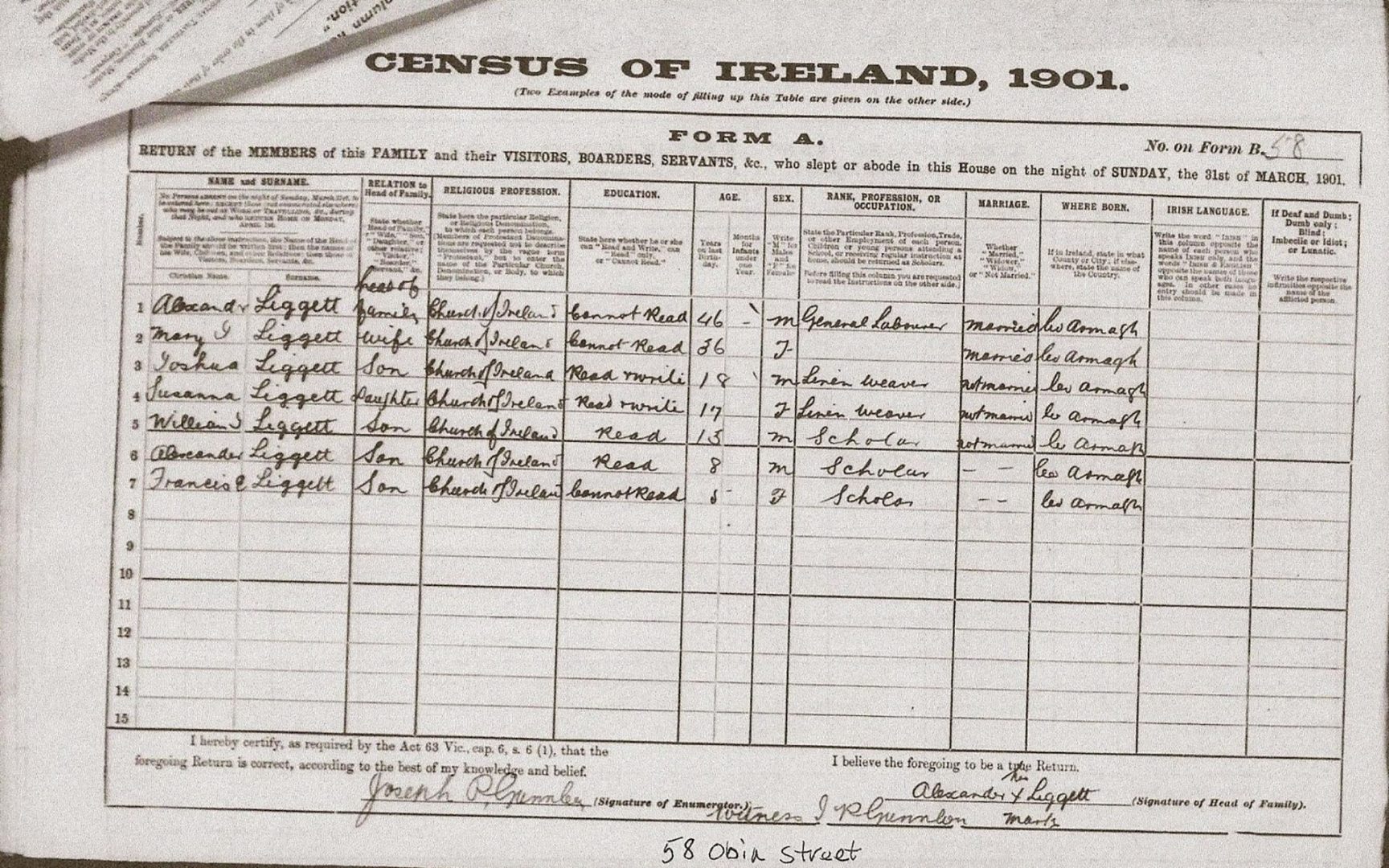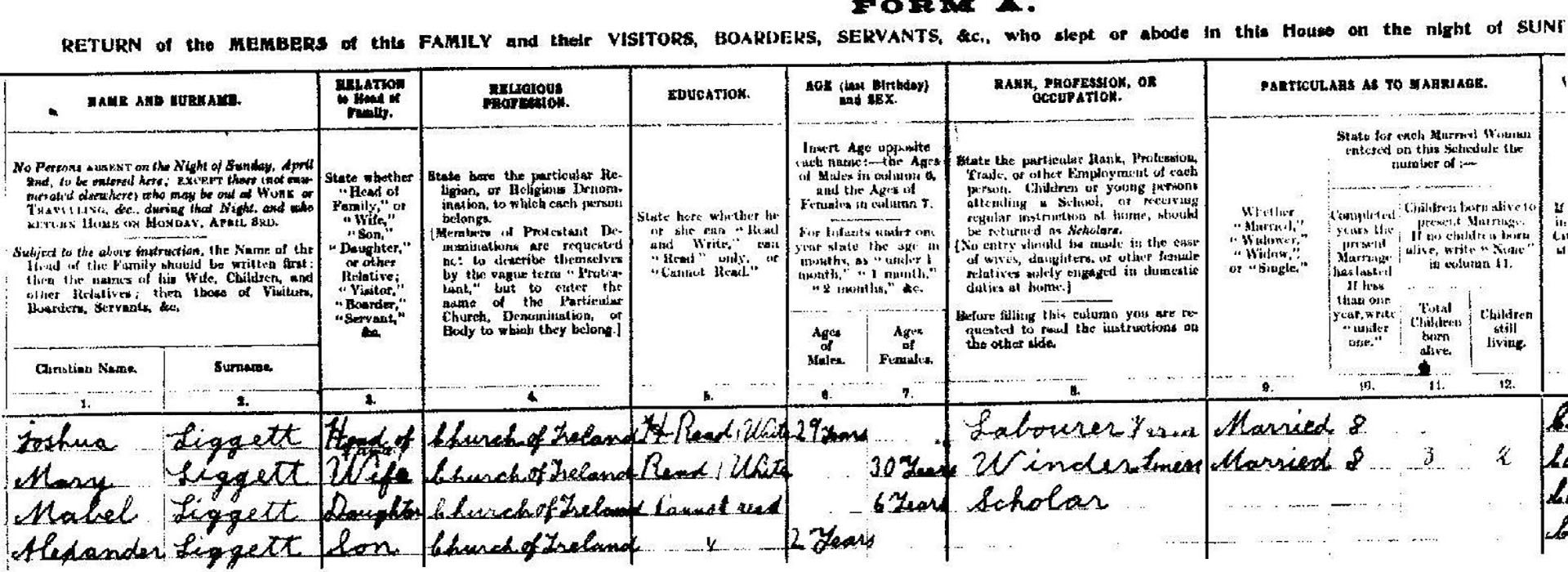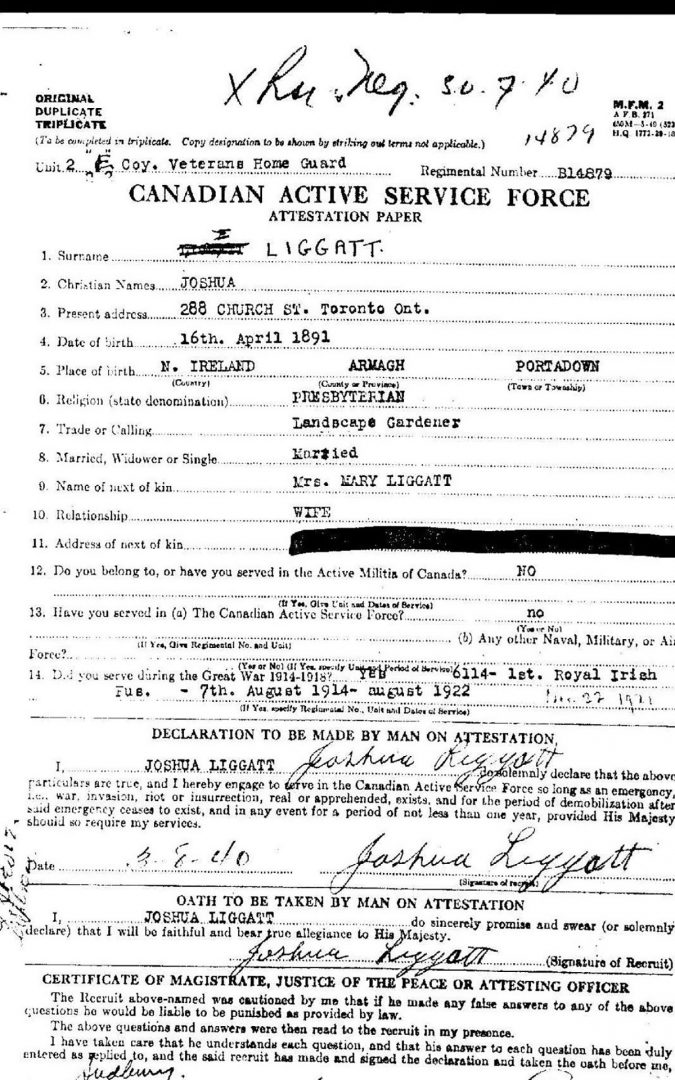Private Joshua Liggett served in The Great War of 1914-1918 and received a Distinguished Conduct Medal. As Private no. 6114, he fought with the 1st Battalion Royal Irish Fusiliers (Princess Victoria's). He would also go on to serve in the Veterans Guard of Canada when war broke out again in 1940.
Joshua Liggett was born on 16th April 1882. He grew up in Breagh, a townland of Portadown in Co. Armagh. The Liggett family would later move towards the centre of the upcoming town. At the age of 18, he features on the 1901 census living with his parents Alexander and Mary-Jane Liggett. Also in the house at 58 Obins Street, Corcrain were siblings Susanna (17), William (13), Alexander (8) and Francis Ellen (5). The family attended the nearby Church of Ireland church at Drumcree. Joshua is a linen weaver and can both read and write in 1901.
In June 1903, he married local woman Mary McCullough in a ceremony in Portadown. By the 1911 census, Joshua and Mary Liggett are head of their own household in 59 Obins Street. Living with them in this house are daughter Mabel (6) and son Alexander (2). At this point in life, Joshua is a labourer, while his wife Mary works as a winder in the linen industry.
At the outbreak of war in 1914, Liggett traveled to the nearby city of Armagh. There, the Royal Irish Fusiliers had their main recruiting area and garrison. Life was about to change for the young Portadown man. Throughout the First World War, Liggett would serve alongside the 10th Irish Division and 36th Ulster Division. The Fusiliers would have seen action at Le Cateau, the Marne, the Somme, Arras, Cambrai, and Ypres. Throughout the campaign, they lost some 1,058 men.
On 4th August 1914, the 1st Battalion Royal Irish Fusiliers were stationed at Shorncliffe, UK. There they formed part of the 10th Brigade of the 4th Division. From Shorncillfe, they moved on to York and Harrow. On 23rd August 1914, the unit mobilised for war and landed at Boulogne, France. They engaged in various actions on the Western Front including:
- The Battle of Le Cateau (1914)
- The Battle of the Marne (1914)
- The Battle of the Aisne (1914)
- The Battle of Messines (1914)
- The Second Battle of Ypres (1915)
- The Battle of Albert (1916)
- The Battle of Le Transloy (1916)
- The First Battle of the Scarpe (1917)
- The Third Battle of the Scarpe (1917)
On 3rd August 1917, the Fusiliers transferred to the 107th Brigade of the 36th Division. After 8th February 1918, they became part of the 108th Brigade of the 36th Division.
- The Battle of St Quentin (1918)
- The Actions at the Somme Crossings (1918)
- The Battle of Rosieres (1918)
- The Battle of Messines (1918)
- The Battle of Bailleul (1918)
- The First Battle of Kemmel Ridge (1918)
- The Battle of Ypres (1918)
- The Battle of Courtrai (1918)
- The action of Ooteghem (1918)
As the war ended on 11th November 1918, the 1st Battalion Royal Irish Fusiliers were at Mouscron to the north-east of Tourcoing, Belgium.
Wartime Honours
In 1918, Joshua Liggett received the Victory Medal. This medal, also known as, the Inter-Allied Victory Medal accompanied either the 1914 Star, the 1915 Star or the British War Medal. The trio was sometimes referred to by squaddies as the “Pip, Squeak, and Wilfred”. To receive these medals, a soldier would have to see action between 5th August 1914 and 12th November 1918. Both men and women alike were entitled to the Victory Medal. Liggett also received the British War Medal. This was for service to the British Empire Campaign between 5th August 1914 and 12th November 1918.
In 1916, Liggett received the Distinguished Conduct Medal. This second level military decoration was for bravery in the field. The award dated back to the Crimean War in 1854. It was a high-level award for military ranks and non-commissioned army. The DCM could be awarded to anyone in the ranks of a Commonwealth Army. It was seen as second only to the Victoria Cross for prestige. Those awarded the Distinguished Conduct Medal could use the letters DCM after their names.
The London Gazette carried the news of Joshua Liggett’s DCM in issue 29508 printed on 15th March 1916. It included the following citation:
His Majesty the King has been graciously pleased to approve the award of the Distinguished Conduct Medal for acts of gallantry and devotion to duty in the field. For conspicuous gallantry when acting as orderly to two Officers who were visiting posts. Both officers were hit by snipers, but Private Liggett dragged them both into a disused trench, bandaged them, went across the open to fetch stretchers, and returned with the stretcher party. All this time he was under heavy fire.
Life after the War
Joshua Liggett was one of the lucky ones who returned from the battlefields of World War One in 1918. He returned to Northern Ireland and remained there until 1926. In March that year, he crossed the Atlantic in search of a better life, arriving in Nova Scotia on 27th March 1926. He would spend the rest of his life in Canada. For reasons unknown, Mary and his young children never made the journey.
By 1940, war had once again broken out in Europe. Joshua Liggett had lived in Canada for fourteen years by this stage. On 3rd August 1940, he would return to military service with the Veterans’ Guard of Canada. This organisation was much like Britain’s home guard and had formed in May that year. In fact, the Veterans’ Guard of Canada pre-dated Churchill’s now famous Home Guard. Among their tasks were guarding prisoners of war, protecting power plants, and factories crucial to the war effort.
The men of the Veterans’ Guard had seen active service in The Great War of 1914–1918. At its height, the guard grew to 10,000 men in 1944 with a further 8,000 men listed on part-time service. These men had applied pressure to the Canadian government to create a guard to protect Canada from invasion. While the men were unfit for frontline duty, their military experience was valuable. These veterans would free up younger men to be sent to the front.
The Veterans’ Guard of Canada was for men under the age of fifty. As boys lied about their age at one end of the scale so too did the veterans who were still keen to play a part. Joshua Liggett was one such veteran.
On 3rd August 1940, Private Liggett signed up to the Canadian Active Service Force. He joined the 2nd ‘E’ Company of the Veterans’ Guard of Canada. His attestation papers refer to them as the “Veterans’ Home Guard”. His regimental number in Canada in B14879 and his job at the time was a landscape gardener.
Mary, still living in Portadown with the children, is Joshua’s next of kin. The Co. Armagh town is listed as his place of birth although he was currently residing at 288 Church Street, Toronto, Ontario. While he did not serve in the Canadian military, his record with the Royal Irish Fusiliers between 7th August 1914 and August 1922 would have impressed the Canadian officers.
On the documents, Liggett has amended his signature to the spelling of”Liggatt”. He has also falsified his date of birth, taking eleven years off his actual age. Rather than 58, this would give him an age of 49 and thereby allow him to serve in the guard. Regardless of military background, at 58 years old, Joshua Liggett would have been too old to serve. His time in the Veterans’ Guard of Canada lasts only three months before he is found out and discharged “unfit for military service under existing standards”.
He served in Sudbury, a small city in Ontario. It is likely he was posted to the Espanola Internment Camp no. 21. Formerly known as Camp E, it was oepened on 7th July 1940. The site had been a mill owned by Abitibi Power and Paper, 40 miles to the west of Sudbury. Over 1,400 German army, navy, and air force prisoners arrived from Britain in July 1940. By May 1943, many of the prisoners were transferred to Lethbridge Camp 133. Espanola closed on 30th November 1943 but Joshua Liggett’s time as an Acting Corporal in the VCG had long since passed.
Having lied about his age, Acting Corporal Joshua Liggett was eventually discharged from the Veterans’ Guard of Canada as unfit for military service in 1940.
Acting Corporal Liggett’s papers provide some very descriptive information. Standing 5’9 1/2, he had black hair, blue eyes, and had picked up many scars through the years. He was marked above the eyebrows, his left knee, his right ankle and the big toe of his right foot. Through his time with the Veterans’ Guard, his conduct was noted as good.
News of Joshua Liggett’s death in Canada was given to his sister Adelaide Woodhouse who was living in Springfield, Massachusetts, USA at the time in 1968.
A life of military service
At 12.20am on 21st March 1968, Joshua Liggett DCM passed away in Sunnybrook Veterans’ Hospital in Toronto. He was aged 86 and a letter dated 5th April 1956 confirmed his death to his sister Mrs Adelaide Woodhouse in Springfield, MA, USA.
The letter extended sympathies from the Department of Veterans’ Affairs. His regimental numbers B14879 (Veterans’ Guard of Canada) and 6114 (Royal Irish Fusiliers) are listed along with the number 33153.
Joshua Liggett’s funeral was held at RS Kane’s Funeral Home on 4812 Yonge Street, Willowdale. The service was conducted by Padre EA Clifford, a chaplain from the Sunnybrook hospital. On his final journey, pallbearers came from the Royal Canadian Legion.
It is fitting that a man who had given so much of his life to serving two countries in two World Wars was looked after by the military until the end.


